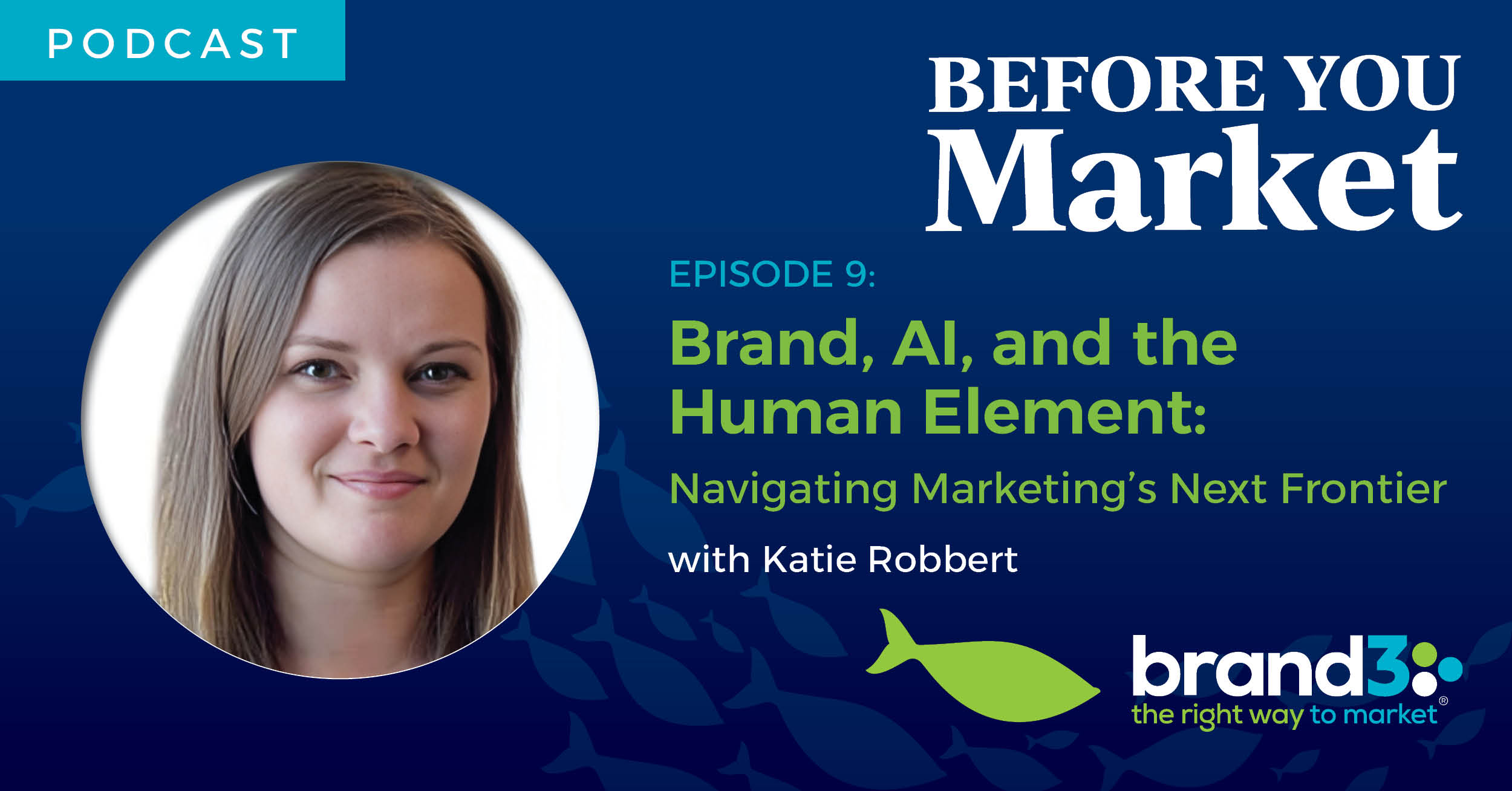

Welcome to the Before You Market Podcast, where we challenge you to “Rethink Marketing.” To help us in the endeavor, we’ve invited some of the best marketers in the business to enlighten you on your path to a brand-first awakening.
Katie is a beast when it comes to data analytics and AI. We're super excited to hear her thoughts and hope you are too. Watch the full episode below!
Katie Robbert is an authority on compliance, governance, change management, agile methodologies, and dealing with high-stakes, “no mistakes” data. As CEO of Trust Insights, she oversees the growth of the company, manages operations and product commercialization, and sets overall strategy. Her expertise includes strategic planning, marketing operations management, organizational behavior and market research and analysis.
Prior to co-founding Trust Insights, she built and grew multi-million dollar lines of business in the marketing technology, pharmaceutical, and healthcare industries. Ms. Robbert led teams of Microsoft Partner Software Engineers to build industry-leading research software to address and mitigate pharmaceutical abuse.
Ms. Robbert holds a Master of Science degree in Marketing and Technological Innovation. She is a published researcher in the Pharmacoepidemiology and Drug Safety Journal. She is a published author in Applied Marketing Analytics. She is the owner and Community Admin of Analytics for Marketers. She is the Community Operations Manager and Ambassador for Women In Analytics.
Jon Bailey 00:04
Oh, hey, hi. How are you doing? So, welcome to the Before You Market podcast. My name is Jon Bailey, and this is where we challenge you to rethink marketing. So, to help us in this endeavor, we've invited some of the best marketers in the business to enlighten you on a path to a brand-first awakening. Yes, that's right, a brand-first awakening. Everybody. If you don't know what that means, just keep watching the podcast.
So Katie is here. Katie is a beast when it comes to data analytics. And she's getting deep into some AI as well. She is also a business partner with two of my favorite people, John Wall and Chris Penn, who we were just discussing before we got started. They are the first to ever do a podcast. There, I said it. You don't have to do any more research. It's been proven.
Anyway, I'm hoping to have each of them on the podcast soon, but I wanted to get Katie on here first because, well, she's my favorite, so don't tell Chris or John. Anyway, Katie, please take a moment and introduce yourself to these wonderful folks.
Katie Robbert 01:23
When you lifted up your sweatshirt to show what was on it, I had to think for a second about what was on my shirt to see if I could do the same. And I realized that I'm promoting a Beer Fest, so I may not be well, but anyway, that's what's on my shirt today. So mine isn't promoting anything related to my company.
Hi, I'm Katie Robbert, CEO of Trust Insights. I definitely don't take myself that seriously, but I do take the right place marketing and analytics and AI and operations and all that good stuff very seriously to the point where it's intense, but I really just want to do like cool things, but do it like in a thoughtful, pragmatic way. So that's who I am.
Jon Bailey 02:12
Yay. Well, thanks for coming. So a mutual friend of ours was the very first guest on this podcast. Of course, I am talking about the amazing Gini Dietrich, and Gini and I got pretty deep into AI and marketing and some other things and I'm kind of hoping you and I will do the same. So are you game for that?
Katie Robbert 02:35
I'm always game.
Jon Bailey 02:38
Let's do this. Alright. So obviously, we're big on brand here at Brand3. It's in the name, and we're trying to take everyone on brand. First awakening thing quest. Anyway, I wanted to ask you, when it comes to, you know, assessing your brand's position in the marketplace. What tools in tech do you find most effective, and you know, in what way? I don't want to get real tech, super technical, and nerdy, but I think people can get lost in some of the tools. And so you guys are always my go-to North Star when it comes to tech recommendations. So that's what I'm asking for here.
Katie Robbert 03:28
Yeah, you know, brand is one of those really interesting topics that I feel means something different to everybody. Absolutely, you know. So when I think about the Trust Insights brand, the brand is really myself and Chris versus, you know, this nameless corporate entity because we're such a small company. And so when you think Trust Insights, it needs to be synonymous with Chris. It needs to be synonymous with me versus you.
Think about, I don't know, like Disney, for example, you might think, Walt Disney, but you might also not know who's the current CEO, who's the face of it, like a big corporation, and so, you know, depending on the size of your company, the makeup of it, and sort of your goals as a brand, is going to change the kinds of tools that you're using. So for us, we use a lot of social listening because if our brand is our personal brand, it's anonymous with our corporate brand.
We need to make sure that we are putting ourselves and our expertise out there on channels like a LinkedIn or an Instagram or a YouTube, whatever makes sense, and that we're also then tracking, are people engaging with it? What's the sentiment analysis? What are they saying? Are they sharing the thought leadership pieces that we're putting out there?
But then you can also start to get into using tools like generative AI you have or ChatGPT, your Gemini, your Claude, your llama, and using it almost as a gut check, a competitive analysis, you can say, I think I'm similar to Jon Bailey. What has Jon Bailey done that I'm not doing? What are the gaps in my career, in my speaking, in my content that he's talking about, that I could also be talking about, that's going to help elevate my brand and bring in the right kind of people?
I, you know, can certainly go deep and talk about making sure you know who your customers are, using AI to build your ideal customer profile. One of the challenges I see with a lot of companies is they think they know who their ideal customer is, but what they're looking at is so far down in the funnel of people who have already signed contracts that, yeah, an ideal customer, someone who's signed up with you and paying but then how do you go back out into, you know, the world wide web and find more people like this?
I think that's where you can use generative AI as a really powerful tool and build your ideal customer profiles. Where are these people hanging out? What are they like? How do I serve them so that I can then build my brand that serves them rather than what I think they need?
Jon Bailey 06:24
I love that using AI as a gut check. That's a great tip, and I kind of want to do that, but I'll wait until we finish this first.
Katie Robbert 06:36
If we see you typing off to the side, then we'll know.
Jon Bailey 06:39
I'll try to be, it's great. So, staying with AI. In a March martech.com post, you were talking about the 5p framework. When using the 5P framework, when implementing AI, you suggest you incorporating user stories, which forces you to think through AI's application from the user's perspective, which is kind of what you were just talking about.
And you say, and I'm going to read this, “having everyone create their own user story allows them to communicate their needs and also take a sense of ownership.” So, I think we often forget about the human element in AI, and I was just wondering to get your thoughts on that, and if, if we're just sort of going letting the tools drive the ship, and we're not really driving it ourselves, do you know what I mean?
Katie Robbert 07:34
Oh, I do, and I'm so glad you asked, because this is where I can really go deep.
Jon Bailey 07:39
Go deep.
Katie Robbert 07:41
Well this a topic I talk about a lot. I was actually recently at Macon in Cleveland, Ohio, lovely Cleveland, and the talk that I gave was very much about how we are approaching integrating artificial intelligence into our companies the wrong way. And this is where the 5P come in. So the 5P framework is very straightforward. It's purpose people process, platform and performance. Why? Because marketers love alliteration. We love that the tricky stuff.
But it really asks the question, why are we doing this? Is this the way we should be approaching it? I really try to challenge my peers and my clients to not lead with the platform, which is the fourth P to not lead with generative AI. Because what happens when we pick the tool first and then try to retrofit it into our processes and our teams and our people and our business goals.
We're now locked into whatever that tool can and cannot do, versus starting with the 5p, starting with your purpose and your people, your user stories, your processes, and then choosing the tool to say, which tool best matches what I'm trying to accomplish best matches the skill sets that I currently have on my team, or given my goals.
Do I need to hire more people and then choose a tool that they're an expert in and train people up? Do I have a clear, concise, repeatable, scalable process where I know if I insert AI into it and something goes wrong, I can point to exactly what's not working, pull it back out, continue the process as it's supposed to be so that work isn't getting interrupted? Because the thing is, we're treating bringing AI into our organization like we have all the time in the world.
We have endless resources to just, like, tool around and try things and experiment like, that's not reality, right? It is absolutely not. We all do not have the same, you know, 24 hours in a day as Beyonce. It's just, you know, the physics isn't there, right?
So we have to be smart about introducing new tech. You know, AI is the thing, but it could be a CRM system. It could be, you know, email marketing, whatever the tool is. If we choose the tool first, we are doing ourselves a disservice and setting ourselves up for failure. And now I feel like I'm up on a soapbox, and I'm ranting and waving my hands, and thanks a lot for that, Jon.
Jon Bailey 10:24
Yes, but it's so important. And I think that brands do the same thing with marketing tactics. I think they go tactic first, instead of focusing on purpose and people. It's kind of what we mean by when we say a brand first awakening is that leading with the brand and deciding who you are and who you're talking to before you go and, you know, dive into tech and tactics is so important. And, I mean, yeah, so preach on Amen.
Katie Robbert 10:55
Happy to do it any day.
Jon Bailey 10:57
Part of the people so, because you can go deep on the techie stuff and all of the processes and operations and things that make my head hurt, I reached out to my one of my favorite people here at Brand three and our marketing services director for a couple questions, because she likes to geek out too. So these are, these are a couple questions from Taverlee Laskauskas, who, as I said, is our marketing services director.
She asks about Performance Max Google ad campaigns, or PMax, which are supposed to use AI to help fill in the gaps in the marketing funnel by delivering ads to users at various points and optimizing for better performance across the funnel. In your opinion, is it worth the hype? Come on.
Katie Robbert 11:59
Personally, no. And I will tell you why. I will tell you exactly why. Let me get back up on my soapbox. Now, I'm just going to build it a couple of levels higher. Nice. So if you're starting and you are trying to figure out where you fit in the market and who your audience is, I feel like a tool like PMax can help you start to experiment and say what's going to work.
However, you still need to take a step back and figure out who your audience is. The challenge with artificial intelligence is it's only as good as the data that you give it. So if you're using a tool like PMax, and you're giving it very basic information, so if I say, I want to run ads to people between the ages of 30 and 40 in the United States that like surfing.
I'm going to get a really, really big audience. I'm going to waste a lot of money, and AI will make assumptions about the rest we know. I know personally, from doing this work, through trust insights, there is so much bias built into artificial intelligence that if you are letting the AI do the work for you, and you're not giving it the data because you don't know who your audience is, you are, once again, not setting yourself up for success. You are potentially wasting money and resources, hitting the wrong people, and not getting brand awareness. It's a waste of time.
Oh, my God, my soapbox is just getting taller.
Jon Bailey 13:33
You to wave your arms a little bit more.
Katie Robbert 13:34
I would, but I'm afraid I would imagine I would not go for my microphone. Unfortunately, trust me, I would love to normally.
Jon Bailey 13:44
Just burn it all down.
Katie Robbert 13:48
But I feel like depending on so think about, you know, the example I was giving earlier. So, like at Disney, I have nothing against Disney. It was just the first big company that popped into my head; a company like Disney is a household name where they can use a system like PMax because they are literally trying to appeal to everybody.
They want to be a company for everybody. So for them, a system like PMax is going to be great because everybody is their customer. A company like mine, not everybody is my customer, so I really need to narrow down who that audience should be before I even start to think about whether PMax is the right tool. It goes back to what I was saying in that MarTech Article of the 5P's of you really need to understand your purpose.
So if your purpose is brand awareness, great, that's a great goal, but you still have a lot of work to do before you even get your hands on a piece of technology, especially a piece of technology that includes AI that's going to do some guessing on your behalf. That's a huge risk to me.
Jon Bailey 14:59
Especially if you haven't done the work on, on ensuring that your brand is in good shape, you know, from all the angles, from design, from content, from user experience, you know, on down through and so, you know, it's the old adage, garbage in, garbage out. So, yeah, absolutely sweet. So follow up from Tav is with all the changes from Google, GA for consent mode, we talked about PMax, etc. How are you rolling with the punches and educating your clients without frustrating or overwhelming them? Or are you? Do you like to just shock them and just dump new technology on them, like, Hey, look at this now. No, I'm just kidding.
Katie Robbert 15:49
As you can tell, I'm definitely that person who likes to like shock and dazzle. I am.
Jon Bailey 15:56
Can you wait real quick? So if that war in Iraq, can you imagine, instead of shock and awe, we called it shock and dazzle, that would be kind of awesome. But anyway keep going.
Katie Robbert 16:05
I think I might have to start doing the shock and dazzle and just see what happens. You know, it's my signature move now, the old shock and dazzle.

Jon Bailey 16:13
Katie Rivera, shock and dazzle. Love it. Anyway,
Katie Robbert 16:17
That has to include some jazz hands, but they have to be like creepy
Jon Bailey 16:20
Creepy and inappropriate, yeah, that doesn't work anyway.
Katie Robbert 16:24
I think those are two things that accurately describe me.
Jon Bailey 16:27
Creepy, inappropriate.
Katie Robbert 16:28
Creepy, inappropriate, yep.
Jon Bailey 16:32
All right, this might just have one as my favorite episode, but keep going.
Katie Robbert 16:38
So in terms of how we're keeping our clients and our peers educated? It's continual. It's non stop, and so it can't be something that we just spring on them. So one of the reasons why people bring on Trust Insights is because we are always looking ahead. We are always trying to figure out what's coming next, because I don't like surprises. I like surprises when they're like, surprise, we're going on a trip. I don't like surprises when it's like surprise. You now have to pay for this brand new tool and hire a bunch of people and learn how to use it and overhaul your company, and suddenly you're in debt and bankruptcy. That's a bad surprise. I don't like those surprises.
Jon Bailey 17:22
Yeah those surprises suck.
Katie Robbert 17:24
So we're always trying to do, one of the things that my business partner Chris does really well is he is always focused on what's next, what's coming, what's the new trend. And then when he brings that into the company, my job is to figure out the so what? Who's going to use it? Who's going to care about it? What's the messaging? What do people actually need to know?
Because if we share everything that's changing, everything that's happening, it's overwhelming. It's overwhelming to us, but our job is to distill it down and really understand our clients. To say, this is the information that you need to know. Here's why you need to know it. Here's the risk of you not paying attention to this trend that's coming so that they can make those decisions and say, Okay, this is something that's just, I'm going to file it, you know, in the back for now.
I don't need to focus on it, versus Okay, you've told me that it's if I don't pay attention. This is a risk. That doesn't mean people are going to continue to pay attention. That sort of is on them, but our the best we can do is say, here's what's coming. Here's what that means for you. Here's our recommendation that you do something about it. And it's a continual thing.
It's something that we have to do every single day so that consistency is there so that people can expect, okay, I'm going to get new information from my partners at Trust Insights every single day. It's going to be bite size. It's going to be something that I can wrap my head around today, and then tomorrow, I'll get a new set of information. And that's really the best way to approach it, because there's so much happening.
Jon Bailey 18:59
Absolutely, I think, you know, I think that can be applied to a lot of things. I think it's important to find people you trust, because it you know, anyone can do research on anything, using Google, using AI, using whatever. But if you A don't understand the information, or B are getting bad information.
You know, it could really do some damage. So I think it's important. So in the notes of of this episode, I'm definitely going to include some links to you guys, because I follow you guys. I follow Trust Insights. I mean this microphone I bought because of Chris Penn and I tell that story all the time, and he's probably sick of hearing it.
But anyway, you know, I think it's important to find people you trust who can who can guide you in the right direction. So thank you for doing the good work that you do. It is appreciated by all.
Katie Robbert 19:58
You are very welcome. That is, I only do it for the accolades.
Jon Bailey 20:02
I figured, what else would I actually help people?
Katie Robbert 20:07
Oh goodness no.
Jon Bailey 20:09
All right, so one more question that is from Little old me. So AI is improving and changing at a crazy fast rate? It freaks me out. So in your opinion, you know, what should businesses be prepared for next?
So I don't want to, like, ask about the future of AI and, like, crystal ball and stuff, but I just want to see what you think in terms of how they should be preparing to utilize AI in terms of, you know, their business practices and marketing, you know, and where you think AI is going to actually have more of more of an impact in the future. Does that make sense?
Katie Robbert 20:53
I'm gonna give you a surprise and dazzle answer that you really need to talk to your teams, you need to talk to your people and ask them where they're struggling and not struggling in the sense of what's AI going to do, but just what is their day to day look like?
What do you what are you currently working on that has you underwater, that if you could get, you know, five minutes back or three hours back would help you do your job better. I think we're so we, as an industry, but also as a culture, are so focused on the next shiny object that we're forgetting about the wins that we can make right in front of us today.
They're going to have such a huge impact on our businesses. You know, as you mentioned, our mutual friend, you know, my ride or die, Gini Dietrich was on your show. She published an article recently about how using AI can get you three hours back, and it's just like, and it wasn't anything, I'll let people go read the article, but it wasn't anything like, you know, I'm building a rocket. I'm applying to Mars.
It's this, like, big engineering feat that I have to have, you know, eight PhDs for. It's very practical stuff that people can apply today. And I think that that is getting overlooked so much because there's so much emphasis on I need to be the first. I need to be the best. It needs to be the shiny object. It needs to be flashy. I had a client say to me, I want to win an innovation award in the context of integrating AI into the organization. And I really had to channel my inner strength to not be like, Are you effing crazy?
Jon Bailey 22:47
That's weird.
Katie Robbert 22:49
That was how they were looking at it. They their thought process was, if we can use AI and we can win an Innovation Award, then we can attract more customers and we can increase our membership numbers. And I was like, or hear me out. Conversely, perhaps we do a little bit of market research, we know that your marketing is misaligned with who you're actually targeting.
Perhaps we make those adjustments. We can use AI a little bit, but let's go ahead and tweak your marketing, and maybe we can, like, shelf this whole innovation award thing, and so it's just the point I'm round about trying to make is that I'm not worried about what's happening with AI tomorrow.
I want to know what I can do today to make my life easier, to make your life easier to find those efficiencies, whether it's with AI or not. To me, AI is just another tool in the toolbox.
Maybe it's tool for this job. Maybe I need a screwdriver, maybe I need, you know, a mallet. Maybe I need all of them. Who knows?
But until I actually do the work to figure out what the real problem is. I'm just picking things out of the toolbox and probably putting holes in my drywall. Most likely, definitely putting holes in my drywall.
Jon Bailey 24:11
I mean, I know what I need. I need an exoskeleton. So, you know, I don't know the rest of it can I don't care, you know, with all your innovation and your new iPhone, and I don't, I just want the exoskeleton so I can pull weeds and not have back pain.
Katie Robbert 24:31
But that, you know is, you know, as much as we're sort of making jokes about it, like that's a really good example of, well, AI is not the right tool for that. So why are we trying to force it to be the right tool for it? It's just not. And so, you know, the question, you know, people often ask is like, Well, what do I What can I do next with AI? What can I do next with AI?
I really try to slow them down and be like, well, what are the problems? You're trying to solve. Let's start there, because then you're just like, piling stuff on top of tools and spending money and, you know, again, my soapbox is just getting taller and taller.
Jon Bailey 25:10
These are important points, because it, you know, it reminds me of a lot of what businesses were saying about social media. You know, it's the same thing. It's like, well, we gotta use social it's like, okay, why for what purpose and who are you? Who are you trying to reach? Well, we just need to be on air.
It's like, I hear the same thing with AI. Now it's just a tool. So if you take nothing else away from this, people understand AI is just a tool to solve a problem that you've taken the time to identify. Very important.
Katie Robbert 25:51
With shock and dazzle.
Jon Bailey 25:53
Shock and dazzle, lot of arm waving happened during this episode. Shock and dazzle, one of the tallest soap boxes ever built, ever constructed. It reminds me of that story with what was it like a turtle who got all the other turtles and it stacked up and see, like its kingdom.
Katie Robbert 26:16
I'm really just standing on turtles.
Jon Bailey 26:18
I figured you were standing on turtles. Turtles, shock and dazzle. Ladies and gentlemen. Katie Robert, thank you so much for doing this. This was awesome.
Katie Robbert 26:29
Thank you for having me. Bye, everybody.






MAILING LOCATIONS
1200 Agora Drive
Suite C #307
Bel Air, MD 21014
OFFICE LOCATIONS
Havre de Grace, MD
Seattle, WA

